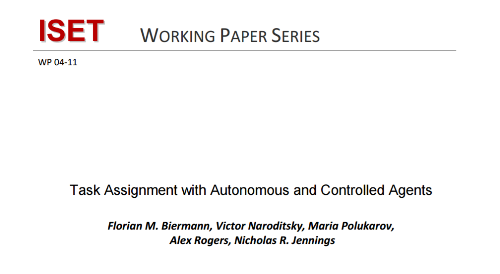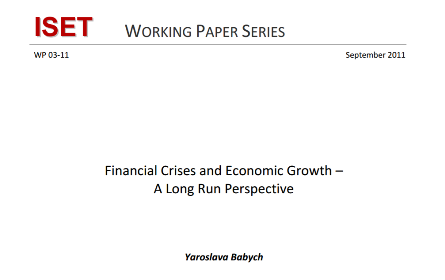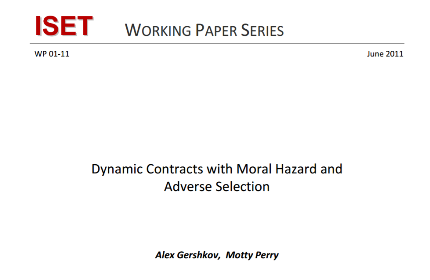Faculty Research
Heterogeneous Convergence

by Daniel Levy, Andrew T. Young, Matthew J. Higgins
We use U.S. county-level data to estimate convergence rates for 22 individual states. We find significant heterogeneity. E.g., the California estimate is 19.9 percent and the New York estimate is 3.3 percent. Convergence rates are essentially uncorrelated with income levels. Read more...
An Application of the Growth Diagnostics Framework: The Case of Georgia

by Yaroslava Babych, Michael Fuenfzig
This paper applies the Growth Diagnostics framework and attempts to identify the binding constraints to economic growth in Georgia. While many policies potentially promote economic growth in practice only policies that relax the binding constraint do so. In contrast, policies that relax non-binding constraints will by definition do little or nothing to promote economic growth. This study builds on an existing growth diagnostics exercise by the Government of Georgia and the Millennium Challenge Corporation, but comes to different conclusions. Read more...
Almost Surely Convergent Summands of a Random Sum
 by S. Chobanyan, S. Leventalc, V. Mandrekar
by S. Chobanyan, S. Leventalc, V. Mandrekar
Published in: Statistics & Probability Letters, Volume 82, Issue 1, January 2012, Pages 212-216
We find a sufficient condition for a.s. convergence to zero of summands given that a sum of two sequences of random variables a.s. converges to zero. The condition turns out to be weaker than that used in the monograph by Loeve and in a paper by Martikainen. Our result is also used in construction of a counter-example regarding the a.s. convergence of a rearranged series. Read more...
A Measure to compare Matchings in Marriage Markets

by Florian M. Biermann
In matching markets the number of blocking pairs is often used as a criterion to compare matchings. We argue that this criterion is lacking an economic interpretation: In many circumstances it will neither reflect the expected extent of partner changes, nor will it capture the satisfaction of the players with the matching. As an alternative, we set up two principles which single out a particularly “disruptive” subcollection of blocking pairs. We propose to take the cardinality of that subset as a measure to compare matchings. This cardinality has an economic interpretation: The subset is a justified objection against the given matching according to a bargaining set characterization of the set of stable matchings. We prove multiple properties relevant for a workable measure of comparison. Read more...
Task Assignment with Autonomous and Controlled Agents

by Florian M. Biermann, Victor Naroditsky, Maria Polukarov, Alex Rogers, Nicholas R. Jennings
We analyse assignment problems in which not all agents are controlled by the central planner. The autonomous agents search for vacant tasks guided by their own preference orders defined over subsets of the available tasks. The goal of the central planner is to maximise the total value of the assignment, taking into account the behaviour of the uncontrolled agents. This setting can be found in numerous real-world situations, ranging from organisational economics to "crowdsourcing" and disaster response. We introduce the Disjunctively Constrained Knapsack Game and show that its unique Nash equilibrium reveals the optimal assignment for the controlled agents. This result allows us to find the solution of the problem using mathematical programming techniques. Read more...
Financial Crises and Economic Growth – A Long Run Perspective

by Yaroslava Babych
In the economic literature the costs of financial crises are typically defined as cumulative output losses until the resolution of the crisis. Given this definition, majority of the empirical studies have documented significant economic costs associated with currency, banking and the twin crises. Few studies, however, looked at the long-term effect of various types of crises. In this paper I estimate the effect of currency, banking and twin crises episodes on the probability of initiating the periods of prolonged and significant growth spurs and downturns – the growth take-offs, and the growth collapses. Read more...
Transparency, Appropriability and the Early State

by Joram Mayshar, Omer Moav, Zvika Neeman
We propose a general theory that explains the extent of the state and accounts for related institutions as byproducts of the state’s extractive technology. We posit further that this extractive technology is determined by the transparency of the production technology. This theory is applied to examine two principal phases in the evolution of the early state. First, we argue that the common explanation of the emergence of the state as a consequence of the availability of food surplus due to the Neolithic Revolution is flawed, since it ignores Malthusian considerations. In contrast, we suggest that what led to the emergence of the state was a transformation of the tax technology that was induced by the greater transparency of the new farming technology. We then apply our theory to explain key institutional features that distinguished ancient Egypt from ancient Mesopotamia, and, in particular, to explain their different land tenure regimes. Read more...
Dynamic Contracts with Moral Hazard and Adverse Selection

by Alex Gershkov, Motty Perry
We study a novel dynamic principal—agent setting with moral hazard and adverse selection (persistent as well as repeated). In the model an agent whose skills are his private information faces a finite sequence of tasks, one after the other. Upon arrival of each task the agent learns its level of difficulty and then chooses whether to accept or refuse each task in turn, and how much effort to exert. Although his decision to accept or refuse a task is publicly known, the agent’s effort level is his private information.
We characterize optimal contracts and show that the per-period utility of the agent approaches his per-period utility when his skills are publicly known, as the discount factor and the time horizon increase. Read more...
Remittances in Georgia: Correlates, Economic Impact, and Social Capital Formation

by Theodore P. Gerber, Karine Torosyan
Using a new data source, the Georgia on the Move Survey, we examine migrant-level, household-level, and contextual variables associated with the probability that a Georgian household receives remittances. We use propensity score matching to estimate how remittances affect particular types of household expenditures, savings, labor supply, health, and other measures of well being more precisely than is usually possible. Read more...
The Real Estate Conundrum in the CEE Office Markets: Thinking Too Big?

by Frederic Laurin, John-John D’Argensio, Thea Goginashvili
In this paper, we investigate the evolution of office market risks and property prices in Central and Eastern European (CEE) cities. We developed a methodology assessing if office property markets have been accurately valuated in CEE cities, using as a benchmark the past evolution of office markets in Western European cities. Read more...
More...
Pricing Interrelated Goods In Oligopoly
Do Immigrants Affect Labor Market Disparities?
Inter‐Country Comparisons of Poverty Based on Capability Approach
Wage Differentials in Israel: Endowments, Occupational Segregation, Discrimination, and Selectivity
CONTACT US
16, Zandukeli St,
0108 Tbilisi,
Georgia
Telephone: (+995 32) 250 71 77
Email: info@iset.ge

